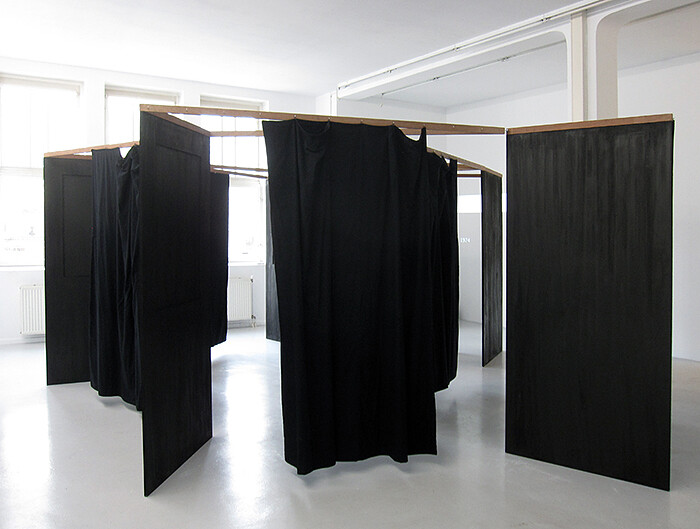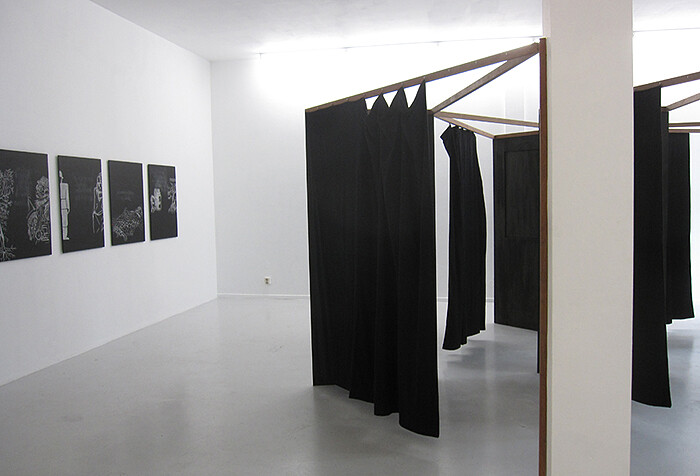Informed by the rather upsetting constellation that “the body is under full attack,” Falke Pisano’s installation at Amsterdam’s Ellen de Bruijne Projects continues along the path set out by her series of works entitled “Figures of Speech” (2005-2010). With figuration now appended to the video lecture-cum-abstract sculpture format, the work’s objective, however, basically remains the same: that of reiterating an act of speech through a sculptural construct, while simultaneously demonstrating the ineffectiveness and futility of this endeavor. In this case, the juxtaposition of Pisano’s trademark didactical projection with a room-wide twisted chain of black screens does the trick. While the video is a mishmash of historical trivia and abstract reasoning—interrupted by the occasional image and diagram—Pisano’s dark paravents mutely occupy the gallery. Guided through them by the artist’s monotone voice, a phenomenological presence is made to resonate within these walls—yet, obviously, full alignment between the spoken word and sculpture is never attained. The work’s alleged “repetition as reoccurrence or sameness” is inevitably obscured by the opacity of the sculpture and projected images respectively, stuck in the quagmire of a neo-Deleuzian utopia from the very beginning. While Pisano promises to transpose the abstract object into the concrete realm of language, this proviso is steadily revealed as a preset disillusion, or a theoretically reinforced cul-de-sac.
If Pisano’s practice thus examines speech as much as it does silence, the abstract as well as the concrete, central to the work are the discrepancies between these two opposing force fields. In the installation, although dominated by the deep-black sculpture, the video claims primordial attention. Nudged in the corner behind the series of screens, the video’s graphics and caricatures present an apocalyptic history of the body, which is slightly if at all abated by the stern solemn voice of the artist. Starting off with a dying gladiator attended by a physician, the sequence of images continues onto an unfortunate soldier’s skeleton; a man fragmented into a near-complete set of agricultural tools; and a woman tied to a ladder being hoisted towards a raging fire—all warmly accompanied by anatomical, psychological and economical theories of bodily stress, ranging from the Greek-Roman thesis of the “four humors” to Charles Samuel Myers’s coinage of the term to describe the condition known as “shell shock.” The video continues with imagery from student uprisings and their aesthetic parallels to be found in Lygia Clark’s Rede de Elásticos (1974), which subsequently shift the body into the post-war epoch, in which political instrumentation is added to the aforementioned strains. As if subjection to gratuitous violence, traumatic stress, or capitalist exploitation was not enough, the body now serves as a focal point for socio-cultural struggle, an instrument to undermine the deadlocks of the Cold War. As such, far from a cheerful bedtime story, Pisano’s narrative installs the human figure in a big doom-laden continuum, hardly if ever succumbing to the cataclysmic forces of the world.
Not surprisingly, after this cumulative pit of misery, turning to the abstract sculpture is something of an emotional relief. The door-like screens, positioned within wooden triangle structures and flanked by distinctively hung curtains, are a difficult match for the portentous language in the video. Sure, Pisano’s post-medial account suggests that these objects mirror the looming forces in the images, abstracting and affecting the body as much as, say, capitalism or politics would—yet the sculpture cannot possibly live up to such contentions. Despite the copious links installed—the sequential structure, the distress implied in black, the bodily scale—it is, and eventually remains, dead material. Its serial nature and rational assembly even hint at minimalist and conceptual paradigms of the 1960s, proposing both a phenomenological matter-of-factness and an ideational lucidity. In such a direct aesthetic experience, then, the viewer is less repressed by malignant forces than drawn into a process of bodily desublimation. He or she may scan the material details, marvel at the diagonal vistas, or enjoy the deadpan aesthetic, all the while enduring—or even slowly negating—Pisano’s unflagging distress call. Not unlike the late work of Lygia Clark (which appended to the artistic event a therapeutic dimension), the opacity of the aesthetic construct here is forwarded as a restorative agent. Its impossibility to fully incorporate the world functions as a remedial quality, a sensible and sensitive rehabilitation of the institutional sphere. In other words, if art is traditionally defined as semi-autonomous and pseudo-transparent, Pisano’s helix is its sculptural twin. It alternatively withdraws from and glimpses at the world, exploring the physical and psychological benefits to be found therein.
Whereas Pisano’s self-reflexive smug has met with mixed enthusiasm in the past, it seems to me that the bodily focus opens up her practice to more nuanced interpretations. She seems to have largely avoided the theoretical impasse in which the work devours itself and its reception on the whole. The question is no longer if abstraction can become fully concrete or the other way around, but how the acknowledgement that it cannot can be made productive, and how this all rhymes with art’s critical faculty in general. Less indebted to the airtight methods of Joseph Kosuth than to the investigatory schemata of Daniel Buren, now seems the time for Pisano to disperse the aesthetic formula onto various themes and sites, and see what it discloses.





